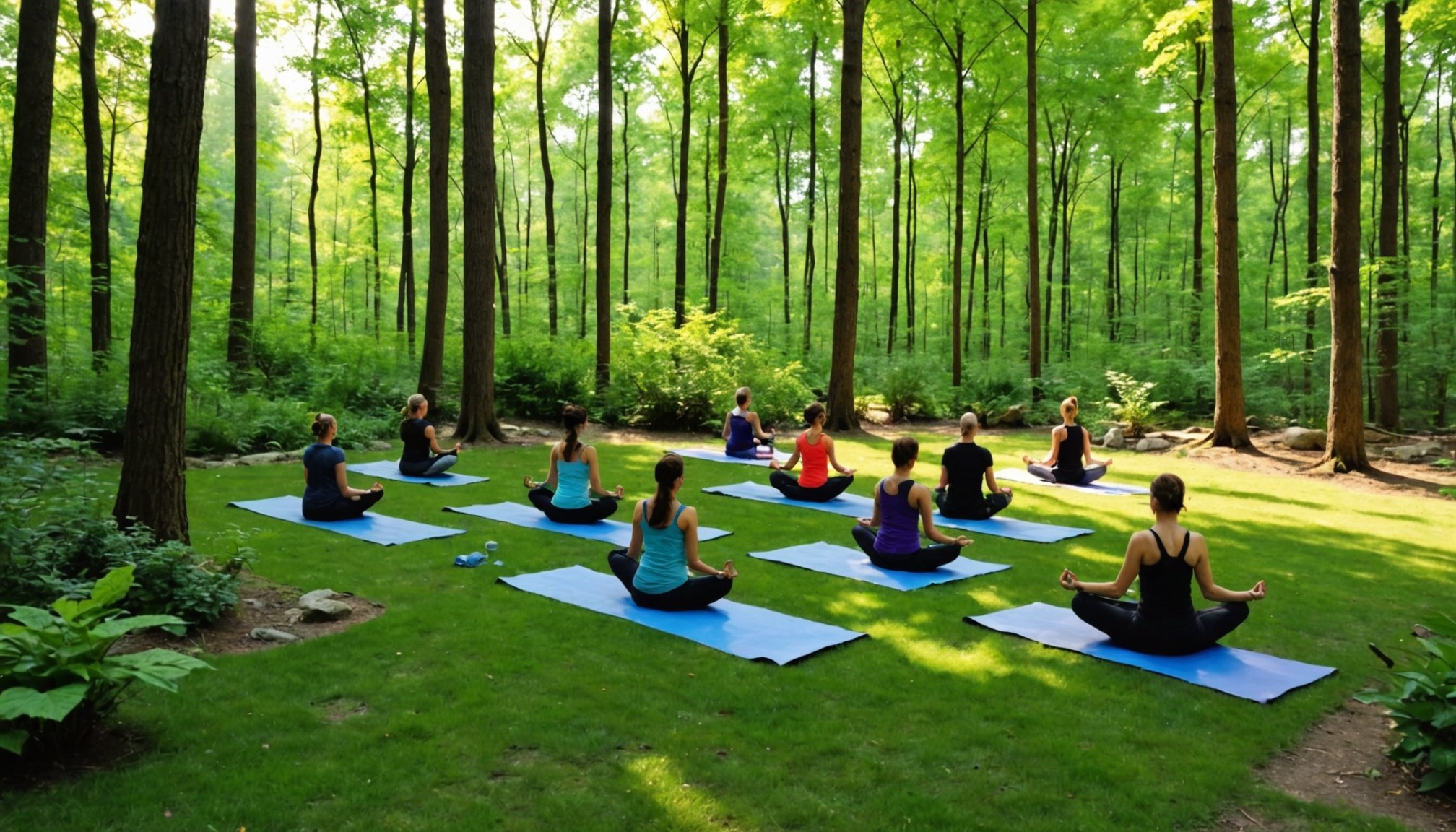Enhancing Your Outdoor Yoga Retreat
Transforming your outdoor space into an ideal yoga in nature retreat is both an art and a science. Selecting the perfect location is crucial for creating a serene environment. Key considerations involve embracing the natural beauty of the area. Look for spaces graced by tranquil elements like water, trees, or mountains. These features not only enhance the aesthetic but also promote a deeper connection with nature during yoga sessions.
When selecting a location, the proximity to natural elements plays a significant role in creating this harmonious atmosphere. Environments near the gentle sounds of a stream, the rustle of leaves in the breeze, or the backdrop of majestic mountains can enrich the yoga experience significantly. Such elements offer soothing soundscapes and vistas that complement the meditative aspects of yoga.
Also read : Transform your bathroom: the definitive guide to choosing perfect water-resistant wallpaper
Furthermore, consider the landscape features and layout in developing a tranquil atmosphere. Utilize natural barriers or strategic placements of plants and stones to buffer and define spaces, enhancing privacy and focus. The arrangement should encourage peaceful practice by offering open, uncluttered spaces. By thoughtfully incorporating these elements, you can effectively transform your outdoor area into a retreat where both body and mind find peace.
Incorporating Natural Features
Incorporating natural elements into your yoga space can elevate your practice and enhance the connection between mind, body, and environment. One effective way to achieve this is by integrating existing natural features like rocks, trees, and flowers. These elements not only add beauty but also create a soothing atmosphere conducive to meditation and relaxation.
Also to see : Mastering home art studio ambiance: your ultimate guide to crafting the ideal adjustable lighting system
When planning your yoga space, consider the landscape integration of these natural features. Arranging mats and seating around existing rocks and trees establishes a harmonious balance with the surroundings. This approach not only maintains the ecological integrity of the area but also leverages the calming effects of nature.
Selecting eco-friendly materials for structures and equipment further contributes to sustainability. Opt for bamboo, reclaimed wood, or recycled materials to create a cohesive and environmentally conscious space. Such choices underscore a commitment to eco-friendly practices and offer a teaching moment on sustainability.
Positioning mats and seating mindfully can also enhance the connection to nature. For instance, align mats to face sunrises or sunsets, capturing the natural light to enrich the yoga experience. Using seating positioned next to flowers or under trees encourages a deep sense of peace, enhancing both the physical setting and the spiritual journey.
Design Elements That Promote Tranquility
In pursuit of creating a serene environment, the design for serenity plays a pivotal role.
Color Schemes
Calming colors are crucial in establishing a tranquil atmosphere. Soft hues like blues, greens, and muted earth tones can significantly influence mood, offering a sense of peace and relaxation. In outdoor settings, these colors blend with natural surroundings, promoting harmony. For instance, integrating shades of blue can mimic the sky or ocean, inherently calming environments.
Textures and Materials
Selecting natural textures elevates both comfort and aesthetic appeal. Organic materials such as wood, stone, and woven fabrics resonate with the serene beauty of nature. They provide a tactile connection to the outdoors, enhancing the meditative ambiance of a space. Think of smooth river stones used in flooring or rustic wood finishes that invite touch and tranquility.
Creating Comfort
Designing cozy nooks for meditation and reflection is essential. These spaces should embody comfort and simplicity, incorporating plush cushions, inviting textiles, and subtle lighting. Providing a dedicated area for meditation encourages mindfulness and relaxation, essential aspects of a calm and soothing environment. In essence, it’s about balancing elements to foster a sanctuary for the mind and spirit.
Yoga Practices to Connect with Nature
Venturing into the outdoors for yoga practice offers a unique experience that anchors one in the present moment, fostering a deeper connection with nature. Utilising adaptable yoga techniques can create a harmonious blend of movement, mindfulness, and environment.
Types Suitable for the Outdoors
Certain yoga styles are more suited to outdoor settings. Hatha yoga is highly adaptable due to its focus on slow and deliberate poses, offering a tranquil way to engage with natural surroundings. Yin yoga, on the other hand, complements outdoor sessions with its deep and meditative posture holds, encouraging reflection amidst nature’s backdrop.
Incorporating Mindfulness
Integrating mindfulness in nature is crucial to maximising the benefits of outdoor sessions. This involves observing natural elements—such as the rustling leaves or chirping birds—as a form of meditation. Mindful breathing, attuned to the rhythmic sounds of the environment, enhances the connection with nature.
Adapting Yoga Flows
Adapting yoga flows to seasonal changes and the natural surroundings is essential. For instance, warming poses during cooler months and cooling sequences during summer optimally align body energy with environmental conditions. The choice to embrace this mindful approach ensures each outdoor session is uniquely immersive and rejuvenating.
Success Stories and Inspiration
Exploring the transformative experiences of outdoor retreats can offer both guidance and inspiration. Connecting with successful retreats provides valuable insight into creating harmonious experiences with nature.
Case Studies
Many outdoor yoga retreats have become paradigms of inspiring designs. Take, for instance, a retreat nestled in the serene woods of Vermont. Participants reported profound connections with nature, made tangible through yoga sessions staged on a tranquil lake’s edge. The retreat’s success stemmed from the careful integration of natural elements into the programming, enhancing the overall experience.
Personal Journeys
Transformative experiences are frequently echoed in personal journeys of those who embark on these retreats. For example, one participant shared how the retreat landscapes helped her find inner peace amidst life’s chaos. The immersive nature of the retreat offered her perspective and renewal, underscoring the potential these experiences hold for personal growth.
Visual Inspiration
The visual allure of these retreats offers plenty to inspire future endeavors. Imagine a sunrise yoga session, where the sky’s vibrant hues act as a backdrop. These inspiring designs can serve as a blueprint for crafting future retreats that seamlessly blend with their surroundings, capturing both the eye and the spirit.











